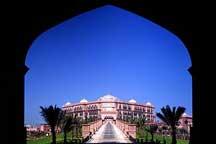 May. 8, 2025
May. 8, 2025
Weather
Paul's Tibet Journal: Good bye to Tibet
2009-09-01 10:28 BJT
By Paul James
Sitting here at the airport just outside of Lhasa, waiting for our delayed flight to Chengdu, which will eventually (we hope) carry us on to Beijing and home, I had time to reflect on the 10 days we spent here on the so-called 'roof of the world.'
It's an interesting analogy to reflect upon. If one were actually sitting on a roof, one would be exposed to the world around you. But in the case of Tibet, thanks to, among other things, its geographic location, one could argue the opposite is true. It's not to say that the people of Tibet are ignorant or oblivious to the world outside their borders. The continual stream of tourists and new inhabitants to their homeland, both foreigners and other people from China, have well taken care of that. But what is plainly evident is that despite the inevitable development that takes place and brings Tibet closer in line with the rest of China and the world, thanks to the isolation over the centuries, there appears to remain a certain amount of duplicity when it comes to the pace at which the Tibetan people choose to embrace change. On the one hand, there seems to be few qualms about embracing commercialism and entrepreneurship. Even outside the major centers such as Lhasa or Shigatse, local Tibetans are ready and willing to accept, and in some cases, demand money for things as trivial as taking a picture of a public marker denoting a point of interest in their land. But on the other hand, there remains a certain pride -- call it a sense of their own history -- that the Tibetan people seeming unwilling to part with.
Even in the multi-ethnic enclave of Lhasa there remains a distinctly Tibetan feel to the community, with the centerpiece of the city, the Potala Palace, being the most visible spot in which the Tibetan people assert their pride through pilgrimage and prayer at the over 1,500 year old heart of Tibetan Buddhism. But once you get out of the major centers such as Lhasa and Shigatse you really begin to notice the way in which most Tibetans live. Small villages dot the landscape in between larger centers. These small villages have an almost pastoral feel to them. And, of course, most of the livelihoods of the people who reside in these small communities depend on the land itself. One stop we made in particular set the impression for me. We were on our way from Shigatse to Jiangzi (Gyangtse) County, about an hour's drive away. Before we arrived, we stopped at a road-side mill which was using a local stream to power the millstones grinding up the local barley, called Tzampa. One of the older Tibetans working in the mill was extremely keen, to the point of pride, to show us how the local Tzampa they milled was made edible. Put into a bag, the powder was mixed with tea and water and turned into a malleable paste which was then set for consumption. Though the actual final product was tantamount to eating moistened cement dust, the pride in which the gentleman showed in creating this concoction, which has been part of the Tibetan diet for generations, was unmistakable.
It's these elements of the Tibetan culture some fear may be lost as development and growth continue in this high mountain land. But from what I've seen of the people who make up the Tibet outside the tourist haunts, it may well be a long time, if ever, before the Tibetan way of life that continues to exist and flourishes today disappears.
 Mail
Mail Share
Share Print
Print


 Video
Video









 2009 China Central Television. All Rights Reserved
2009 China Central Television. All Rights Reserved